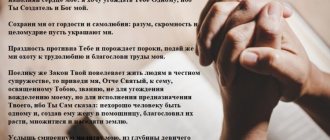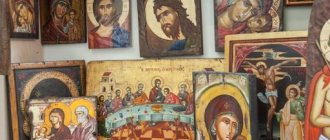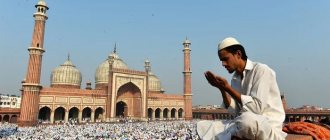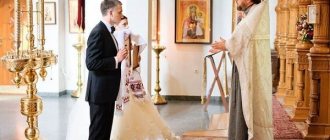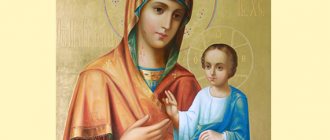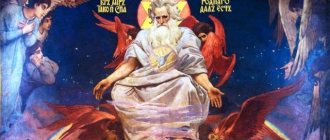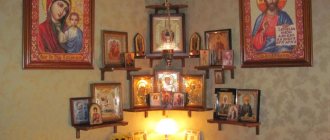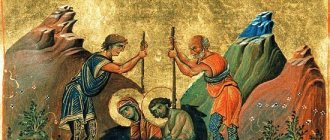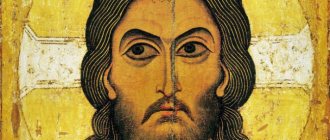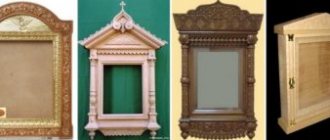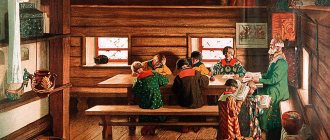- Icon of All Saints - history of the image
- The meaning of the icon of All Saints
- What does the shrine help with?
- Prayer to All Saints
Orthodox iconography is an amazing field of art in which expressive metaphorical images from the Bible and the lives of the Lord's saints are visibly embodied with the help of stylized techniques and extraordinary methods of work. It is this combination that allows you to create the best sacred works, which rightly include icons of all saints - photos and their meaning, as well as what requests are made for this relic, are outlined in our article!
Simeon the God-Receiver
Saint Simeon is one of 72 scholars who translated the Holy Scriptures from Hebrew into Greek at the request of the Egyptian king Ptolemy II Philadelphus (285-247 BC). While working, Simeon did not believe the words of the prophet Isaiah that the Virgin would give birth to the Savior and wanted to write the word “Wife,” but an angel who appeared stopped him and said that Simeon would not die until he saw Him in person. This happened near the Jerusalem Temple, where Joseph and the Mother of God brought the Infant Christ according to Jewish custom. According to legend, Simeon the God-Receiver lived 360 years. These Gospel events are described by the Apostle Luke (Luke 2:25-35).
New Testament Trinity
In addition to the canonical image of the “Old Testament Trinity,” there is also a tradition of depicting the “New Testament Trinity.” From a theological and canonical point of view, these images are very controversial, since, firstly, they share the single essence of the Trinity, and secondly, they depict God the Father. According to the words of the Apostle John: “No one has ever seen God; The only begotten Son, who is in the bosom of the Father, He has revealed.” (John 1:18) The iconography of God the Father in the form of an old man goes back to the text of the book of the Prophet Daniel: “... behold, with the clouds of heaven came one like the Son of man, came to the Ancient of Days and was brought to Him. And to Him was given dominion, glory, and a kingdom, that all nations, nations, and languages should serve Him” (Dan. 7:3-14). However, theologians have always been against such images and attempts have been made repeatedly to ban such iconography as heretical. The Moscow Council, held in the 17th century, decided that “Lords of Hosts” should not be written, because “only Christ was seen in the flesh, as he is painted, that is, depicted according to the flesh, and not according to the Divinity.” That is, anthropomorphism in the depiction of God the Father (and at the same time the Holy Spirit) was rejected.
But there is a version that on many icons of the “New Testament Trinity” it is not the hypostasis of God the Father that is depicted, but Christ - but in the form of the very “ancient of days,” according to the prophet Daniel, who will reign forever, that is, after the Last Judgment. Indeed, on one of the icons, called “Fatherland,” God the Father is depicted on the throne, and on His knees is Christ Emmanuel (the Child), holding in his hands a sphere with the image of a dove, symbolizing the Holy Spirit. Both the Father and the Son on this icon have cross-shaped halos, and the clave is written on their clothes - attributes characteristic only of the image of the Savior. In addition, there are images of Christ, where He is depicted precisely as an old man (for example, the now lost fresco “Christ the Ancient of Days,” in the Church of the Transfiguration on Nereditsa of the 12th century, Greek miniatures of the 13th century). The basis for such a controversial depiction of the Trinity is precisely the words of the Gospel that the Son revealed the Father, and therefore He must be depicted as the incarnation of the Holy Trinity. By the way, among the images of the “Old Testament Trinity” you can also find icons where all three angels are signed “IC. HS,” illustrating the same idea that it was Christ who revealed God to us. And therefore, only such iconography - that is, the “Old Testament Trinity” - seems to be the most correct from a dogmatic point of view. The images of the “New Testament Trinity” are considered non-canonical in the Orthodox Church.
Conception of John the Baptist
Church holiday celebrated on October 6. The parents of the prophet John, righteous Zechariah and Elizabeth, could not have children for a long time and were already of advanced age. An angel who appeared predicted the birth of a son for Zechariah, but the priest did not believe it and for this he lost his speech before John was born. The Evangelist Luke writes about this (Luke 1:5-22).
Does praying at an icon help?
Skeptics may doubt whether prayers near the icon really help Peter and Fevronia. But true Orthodox Christians never doubt love and protection. It is their faith that fuels the prayers addressed to the holy couple with requests and gratitude. There are hundreds of testimonies of how saints helped couples find each other in a sinful world, how they saved people from sin and hopelessness. Here are just a few examples.
- Ekaterina from Moscow said that her grandmother, who lived in the village, was getting ready to get married. The day before, her godmother gave her an icon of Peter and Fevronia. The bride prayed before going to bed, and at night she dreamed of Peter, telling her to wait for her man and to break off relations with this groom. In the morning, a notable quarrel broke out, in which the groom, a true communist, demanded to throw the “nonsense” out of his head and burn the icons and crosses. The relationship was severed. A few months later, Catherine’s grandmother met a guy whom she married. She lived in perfect harmony with him for 60 years.
- A mother from the Moscow region said that she repeatedly prayed at the icon with a particle of relics, asking him to send her a pious husband, and her prayers were heard.
- There are several testimonies of how, after sincere prayers to Peter and Fevronia, family life, which had previously been bursting at the seams, was improved. For many, all that was required was to get married in the temple.
- A woman named Maria said that she was already 40 years old, and still had no children, although she had been married for more than 10 years. All sorts of treatment methods were tried, but to no avail. Then a friend advised me to go to the relics of Peter and Fevronia and pray earnestly. This helped, and a year later she had a newborn baby in her arms.
- Many parishioners said that after sincere prayers for intercession and the preservation of the family, their unfaithful husbands returned, begged for forgiveness and lived righteously.
After such frank stories, is it possible to doubt the power of the patron saints? You need to sincerely pray and believe, then your prayers will be heard. After the prayer, many described their feelings as elated, joyful, as if they were instilled with faith that a miracle would happen, and lightness and sincere hope appeared in their hearts.
Many, after visiting the temple, decide to purchase an icon of the saints for their home - this is a very good decision that will help in fulfilling vows and requests.
Maria and Elizabeth
Meeting of the Virgin Mary and Elizabeth, mother of John the Baptist. It took place in Jerusalem after the Annunciation, when the Archangel Gabriel told the Mother of God about the birth of the Savior from her and the Holy Spirit. As a sign that God can perform any miracle, the angel told the Virgin Mary about her cousin, the righteous Elizabeth, who, even in old age, managed to become pregnant for the first time. Having met, the expectant mothers greeted each other with prophetic words, which the Church adopted into its hymns: “...my soul magnifies the Lord, and my spirit rejoices in God my Savior...” (Luke 1:39-56).
Where are the relics buried and where are they kept?
The wonderful story of moving into one coffin after death may be a legend, but the fact remains that the prince and princess were buried together. Their relics are kept in the Holy Trinity Convent in Murom. This is the main shrine and it is here that the greatest presence is felt. If parishioners need a lot of help, then they should come here.
In addition, there are several churches in Moscow where icons with particles of holy relics are located. This is the Church of the Ascension of the Lord on B. Nikitskaya Street, the Church of St. Sergius and Herman of Valaam and the Church of the Icon of the Mother of God “The Sign” outside the Petrovsky Gate. People from all over Russia also come here to pray and ask for mercy from the patron saints. There is an icon with a particle of relics in the village. Fedoseevka, Belgorod region in the Church of the Intercession of the Blessed Virgin Mary. By visiting these temples, there is a greater chance that prayers will be answered.
Chief Apostles Peter and Paul
Two people very different in character and origin: Peter is a simple fisherman from Judea who followed Christ; Paul is an intellectual and an excellent speaker, initially a persecutor of Christians. They did not preach together, but they are often depicted together on icons, as they are called “first-supreme” for their labors. Tradition also says that the apostles were executed for preaching Christ at about the same time - Peter was crucified, and Paul’s head was cut off.
LiveInternetLiveInternet
We have compiled a catalog through which you will learn to identify saints in medieval Catholic images by their main attributes
Mikhail Mayzuls. Medieval historian
Illustrator Denis Filin
Stones, shoes, arrows - a catalog through which you will learn to recognize saints by their attributes
Why do saints need attributes?
By the late Middle Ages, many European saints acquired individual attributes. Like coats of arms, they made it possible to identify their owners in the long rows of patrons who lined up around the portals of Gothic cathedrals or looked down on parishioners from gilded altarpieces. Attributes replaced signatures (or supplemented them), and not only helped to recognize the saint, but reminded of the circumstances of his martyrdom, main miracles, healing specialization or spiritual gifts. These were not just signatures, but a kind of business cards that introduced the saint to the viewer.
At the same time, attributes were never distributed centrally and were not recorded in any codes (like armorials). These varied from country to country; one saint could have many different attributes, and the same attributes (books, lilies, stars, not to mention instruments of torture) belonged to different saints. It was a living system, where legends gave rise to new symbols, and symbols sometimes gave rise to legends to explain what they meant and how they came to be.
Of course, one should not think that when depicting this or that saint, medieval masters necessarily presented him with an attribute (in some regions or workshops such “calling cards” were used almost everywhere, others used them only from time to time), or that without the help of attributes the saints were indistinguishable. No less, or even more significant were the differences in facial features, hairstyles (for example, St. Paul is usually represented with a bald head), clothes (St. John the Baptist is often dressed in skins), etc. And the signatures - under or above the figures, on halos, on scrolls, etc. - you shouldn’t write them off. However, although attributes were not the only identifying mark of saints, in the late Middle Ages they were one of the important tools that helped to navigate the extensive church iconography.
Attribute history
Although images of saints have become
Don't cry for Mene Mati
“Don’t cry for Me, Mom” - this is how you can translate the words of Christ addressed to the Mother of God into Russian. The source of the iconography is the church hymn of the same name, which is sung on Holy Saturday on the eve of Easter: “Do not weep for Me, Mother, / seeing how / the Son lies in the tomb, conceived in Your womb without a seed: / for I will rise and be glorified / and, as God, I will exalt in glory all who / with faith and love / constantly magnify You.”
The icon depicts the Savior taken down from the cross, who has already been placed in the tomb, and the Mother of God, embracing His body for the last time.
The meaning of the icon of All Saints
According to the letter of the Apostle Paul to the Ephesians, every person is given grace according to the measure of the Lord’s gift, and it can be worthy of both a righteous life and death for the glory of the Creator. It follows from this that holiness does not depend on whether the ascetic was recognized by the church - there are unknown martyrs and passion-bearers, information about whom has not reached our days. No less important were the acts of educators, sages, missionaries and rulers who contributed to the spread of the Christian faith - the icon of all saints reminds of them.
In addition, the relic is the personification of the Church Triumphant, or Heavenly. This is a gathering of all righteous followers of Jesus, led by the Savior himself. Such a congregation is free from misunderstandings, conflicts and disagreements, and is permeated with love, peace, mutual understanding and joy. In other words, the image demonstrates an ideal example of selfless service to the Creator, when any inequality and earthly differences lose their meaning.
Sweet Kiss
"Sweet Kissing", in Greek "Glycophilus". The miraculous icon, which is kept in the Athos monastery of Philotheus (Greece). According to legend, the icon came to the monastic peninsula by sea from Constantinople (Istanbul, Turkey) in the 9th century during the reign of the iconoclast emperor Theophilus. The icon belonged to the wife of one of his confidants, who, to please his boss, destroyed icons and once demanded the same from his wife. But she did not give up the image and launched it across the sea. This is how the icon came to Athos.
The Story of a Godly Couple
The story of the life and love of the Murom prince Peter and Fevronia became known to the world thanks to “The Tale of Peter and Fevronia of Murom,” a work that came from the pen of the monk-chronicler Ermolai-Erasmus (16th century). This story about the holiness of marriage, about the endless fidelity of the chosen one, about the humility of true Christians instantly won the hearts of the people and entered the centuries as an example of how to love and honor your family and God.
The younger Prince of Murom Peter helped his older brother Prince Paul get rid of the Serpent, who, when he was not at home, took on his appearance and flew to his wife for fornication. The wife cunningly found out that the Serpent would receive its death only at the hands of Peter. One day, returning home, Peter saw Paul in two places at once and realized that one of them was the Serpent. He fought with the damned one and killed him. The serpent, dying, turned into itself and splashed Peter with its blood. This caused the younger brother to develop terrible ulcers all over his body. Many tried to cure him, but to no avail. Only when Peter resigned himself to his fate did the Almighty send him a vision. It seemed to him that there was only one person in the world who could cure a man - the daughter of a simple Ryazan beekeeper, Fevronia.
In the story, the girl appears from the first minute as very wise and knowledgeable. She speaks sternly to the messenger and agrees to help the young prince. In return, she asks Peter to marry her, he agrees, because he has a beautiful and smart girl after his heart. However, when Peter recovers, he, fearing the wrath of the boyars who did not approve of the union of the prince and the commoner, refuses to fulfill the agreement.
After a while, he is again struck by a strange illness, and Peter sends a messenger to Fevronia. She doesn't refuse to help. When she healed the man again, he fulfills his agreement and marries the commoner, no longer fearing the wrath of others.
After the death of Paul, Peter becomes a prince, but the boyars did not forget that he went against their will, and at the behest of his heart and by order from above, he married a simple peasant woman. They put the prince before a choice: either exile with his wife, or reign and abandon Fevronia. But this time Peter proved himself to be a faithful and loving husband. He chose exile. He and his wife are sailing on a ship along the Oka River. Tradition says that it is there that divine grace descends on them.
After a while, unrest began in Murom; the vacated throne could not be divided. The boyars were forced to ask the prince to return. So Peter and Fevronia reigned in their place.
In old age they took monastic vows and lived in a monastery. As the legend says, they died on the same day. They bequeathed to bury them in one coffin, but the monks decided that this was contrary to Christian law and took them to different churches, but the next morning their bodies were together again. After such a miraculous intervention, no one dared to move them.
Holy Martyrs
Martyrs - which include the majority of saints - are those who endured suffering and death for the name of Christ, for the right faith, for refusing to serve idols.
Those who have endured especially cruel torment are called great martyrs . Among them are the healer Panteleimon (August 9), St. George the Victorious (May 6), Saints Barbara (December 17) and Catherine (December 7).
Great Martyr George the Victorious
The holy martyrs accepted death in the priesthood, and the holy martyrs died in monastic vows.
Hieromartyr Vladimir of Kyiv and Galicia
Pre-martyr Korniliy of Pskov-Pechersk
Separately in Russia they honor the passion-bearers who died at the hands of murderers and villains. The first Russian saints were the passion-bearing princes Boris and Gleb (August 6).
Boris and Gleb
The prototype of martyrdom is Christ Himself, who witnessed with his own blood the salvation of the human race.
The martyrs (from the holy protomartyr Stephen (Acts 7) to the new martyrs of our time) are continuers of the apostolic ministry, and therefore there is a cross on their icons. It is depicted in the hands of a saint and is a symbol of both the apostolic gospel and the symbol of sacrifice. Joyfully giving earthly existence in exchange for heavenly existence, the martyrs become co-workers with Christ Himself.
The iconography of martyrs uses the color red as a figurative expression of suffering for the faith, and the red robes of martyrs are a symbol of shed blood.
Church calls those who suffered a lot for Christ, openly confessing their faith, endured persecution, torment and torture for this, but survived, avoiding martyrdom. Since the 6th century, confessors have been called saints who have attested to the Christian faith through the special righteousness of their lives.
Venerable Nicholas the Confessor, Abbot of Studitsky
Reverends
Venerables (those who have become like the Lord) are saints who became famous in monastic feats. Through fasting, prayer, and labor, they created great virtues in their souls - humility, chastity, meekness. Almost every monastery is glorified before God by a holy saint. In Rus', the Venerables Sergius of Radonezh (July 18 and October 8) and Seraphim of Sarov (January 15 and August 1) are especially loved. Among the venerable women, the most famous is Saint Mary of Egypt (April 14).
Monastic asceticism is a special type of following Christ, which involves a complete renunciation of all worldly attachments. The basis of monastic feat is fasting and prayer as a path to knowledge of God and striving for life in God. But monasticism is not only a means of personal salvation. “Save yourself, and thousands around you will be saved,” these words of St. Seraphim of Sarov indicate that the difficult monastic feat is marked by special gifts of God, using which the ascetic leads to the salvation of all his spiritual children.
The monks are depicted in full height and to the waist, in monastic vestments; right hand - in a nominal blessing finger; in the left - there may be an unfolded or, most often, a rolled scroll; A characteristic detail of the iconography of the saints is the rosary - a symbol of monastic prayer work.
The background for icons of saints can be a panoramic image of the monastery in which the saint labored.
Standing on the pillars are depicted the holy venerable pillars, who have chosen this type of extreme asceticism for themselves as a way of withdrawing from the world and concentrating on unceasing prayer.
Often on icons (this applies to all the iconography of saints) there is an image of the blessing right hand of the Lord, the Lord Jesus Christ Himself, the Mother of God, angels and archangels.
The figures can be single, but there are also multi-figure compositions, called “icons with selected saints.” Single figures are depicted surrounded by hagiographical marks - individual scenes from the life of the saint.
Sergius of Radonezh
Icon of the Savior Pantocrator in the museum collection
Currently, the icon “Savior Pantocrator” can be found not only in churches, but also in museums. Canvases by ancient artists are of cultural value to historians.
Russian State Museum
The Internet allows you to view icons located in various museums without leaving your home. The image of “Savior Almighty” is exhibited in the Russian State Museum and is of historical and cultural value. This work was written in 1728 by the great icon painter Kirill Ulanov and is considered his last work. The artist died presumably in 1731.
The image was created in Yuryevets-Povolsky, on the territory of the Epiphany Church, located next to the Trinity Krivozerskaya Hermitage. Here abbot Cyril (Cornelius) spent several years and created many icons with which the Sretenskaya Church was decorated.
RECOMMENDED: Complete collection of prayers to the Lord.
Initially, the icon of the Savior Pantocrator was placed on the right side of the Royal Doors of the Presentation Church in the local row. The composition is similar to the image of “Pantocrator”, painted by Simon Ushakov in 1668 by order of the clergy of the Moscow Church of St. Gregory of Neocaesarea. On the pages of the open book a fragment from chapter 25 of the Gospel of Matthew is read. He talks about the Savior, presenting him as the Lord of the world, and has an eschatological sound.
In the upper part are depicted the archangels Gabriel and Michael with the instruments of the Passion in their hands. Thanks to the archaic language of the icon, the image is devoid of “lifelikeness.” Simplified writing techniques gave the Savior’s face special expressiveness.
The icon was temporarily removed from the church and restored to the Russian State Museum in 1955-56. Since 1957, it has been on display at the museum.
State Hermitage Museum
The place where the image was created is Rostov province. The first location is the wooden church of the Vazentsy churchyard named after the Prophet Elijah, on the Onega River. Tempera technique. The time of creation is the beginning of the 14th century.
The Almighty Savior was the central image in the diesus row - the main part of the iconostasis. The Savior is depicted in red robes, with an open book and his right hand raised in blessing. The image of Christ symbolizes the intercession of the saints during the Last Judgment for human souls.
You can view the icon in Hall 146 of the Winter Palace. Or by typing in the Hermitage search engine the category “painting”, section Russian art and culture.
Prayers in front of the icon of the Almighty Savior deliver from temptations and sinful thoughts, heal the soul, and protect from attacks from enemies and troubles. The one who prays strengthens his spirit and gains the strength to pass all tests with dignity.
Holy saints
The holy believers are kings and princes who used the greatness and wealth received from God for works of mercy, enlightenment, and the preservation of people's shrines. Among them are Alexander Nevsky (September 12 and December 6) and Dimitry Donskoy (June 1).
Alexander Nevskiy
The main theological meaning of all the iconography of the saints is victory over sin, and therefore over eternal death, salvation and entry into the Kingdom of Heaven. According to St. John of Damascus, “the saints were filled with the Holy Spirit during their lifetime, but when they died, the grace of the Holy Spirit is present with their souls, and with their bodies in tombs, and with their figures, and with their holy icons - not in essence, but by grace and action."
Holiday icons
The day of remembrance of the canonical icon “Three Joys” is celebrated on January 8.
Many parishioners flock to the Trinity Church on Gryazi in Moscow on this day. Believers strive to behold the holy face and pray for intercession, peace and strong union.
Unfortunately, the original icon was lost during the Stalinist persecution of the church; a copy of the shrine is kept in the church. Other miraculous copies are also known.
Sources:
- https://ikona-i-molitva.info/ikona-svyatoe-semejstvo-znachenie-v-chem-pomogaet/
- https://omolitvah.ru/ikony/ikona-svyatoe-semeystvo/
- https://verovat.com/ikony/svyatoe-semejstvo.html
- https://molitva-info.ru/ikony/ikona-svyatoe-semejstvo.html
- https://1001molitva.ru/ikony/svyatoe-semejstvo.html

